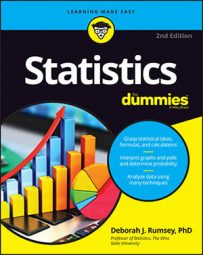A statistical distribution is a listing of the possible values of a variable (or intervals of values), and how often (or at what density) they occur. It can take several forms, including binomial, normal, and t-distribution.
A variable is a characteristic that's being counted, measured, or categorized. Examples include gender, age, height, weight, or number of pets you own.
Different types of distributions exist for different variables. The following three distributions are the most commonly occurring distributions in an introductory statistics course, and they have many applications in the real world:
If a variable is counting the number of successes out of a certain number of trials (such as the number of people out of 100 who got well by taking a certain drug), it has a binomial distribution.
If the variable takes on values that occur according to a "bell-shaped curve," such as national achievement test scores, then that variable has a normal distribution.
If the variable is the average of your observed samples and you have limited data, such as in a test of only ten subjects to see if a weight-loss program works, the t-distribution may be in order.
The t-distribution also takes on the "bell-shaped curve." The main difference between the normal distribution and the t-distribution is the sample size. The normal distribution is used when the sample size is at least 30, while the t-distribution is used when the sample size is less than 30.
When it comes to distributions, you need to know how to decide which distribution a particular variable has, how to find probabilities for it, and how to figure out what the long-term average and standard deviation of the outcomes would be.

